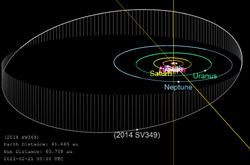Astronomy:2014 SV349
 Orbital diagram of 2014 SV349 | |
| Discovery[1][2] | |
|---|---|
| Discovered by | S. S. Sheppard |
| Discovery site | Cerro Tololo Obs. |
| Discovery date | 19 September 2014 |
| Designations | |
| 2014 SV349 | |
| Minor planet category | |
| Orbital characteristics[3] | |
| Epoch 1 July 2021 (JD 2459396.5) | |
| Uncertainty parameter 5[1] · 6[3] | |
| Observation arc | 2.83 yr (1,035 d) |
| |{{{apsis}}}|helion}} | 88.398 AU |
| |{{{apsis}}}|helion}} | 35.026 AU |
| 61.712 AU | |
| Eccentricity | 0.4324 |
| Orbital period | 484.81 yr (177,075 d) |
| Mean anomaly | 297.13° |
| Mean motion | 0° 0m 7.2s / day |
| Inclination | 17.785° |
| Longitude of ascending node | 56.651° |
| 23.717° | |
| Physical characteristics | |
| Mean diameter | 423 km (est.)[4][7] |
| Absolute magnitude (H) | 5.1[1][3] |
2014 SV349 is a large trans-Neptunian object from the scattered disc located in the outermost region of the Solar System. It is one of the most distant objects from the Sun at 60.5 AU. The object is a dwarf planet candidate and measures approximately 423 kilometers (260 miles) in diameter. It was discovered on 19 September 2014, by American astronomer Scott Sheppard at the Cerro Tololo Observatory, Chile, and was provisionally designated 2014 SV349.[1]
Orbit and classification
This minor planet orbits the Sun at a distance of 35.0–88.4 AU once every 484 years and 10 months (177,075 days; semi-major axis of 61.71 AU). Its orbit has an eccentricity of 0.43 and an inclination of 18° with respect to the ecliptic.[3]
It is classified as a scattered disc object,[4] or "near-scattered" object in the classification of the Deep Ecliptic Survey,[5] that still gravitationally interacts with Neptune (30.1 AU) due to its relatively low perihelion of 35.0 AU, contrary to the extended-scattered/detached objects and sednoids which never approach Neptune as close.
Most distant objects from the Sun
2014 SV349 is moving closer to the Sun and will come to perihelion in 2106.[3] (As of 2021), it is at 60.5 AU from the Sun,[8] which makes it one of the most distant objects in the Solar System.[9]
Physical characteristics
Based on a generic magnitude-to-diameter conversion, 2014 SV349 measures approximately 423 kilometers (260 miles) in diameter, for an assumed albedo of 0.9 and an magnitude of 5.1.[4][7] Mike Brown considers this object to be a likely dwarf planet candidate ("probably") estimating a mean-diameter of 449 km (280 mi).[6] (As of 2021), no rotational lightcurve for this object has been obtained from photometric observations. The body's rotation period, pole and shape remain unknown.[3]
See also
- List of possible dwarf planets
- List of Solar System objects most distant from the Sun
References
- ↑ Jump up to: 1.0 1.1 1.2 1.3 "2014 SV349". Minor Planet Center. https://www.minorplanetcenter.net/db_search/show_object?object_id=2014+SV349.
- ↑ "MPEC 2016-Q75 : 2014 SV349". Minor Planet Electronic Circular. Minor Planet Center. 31 August 2016. https://www.minorplanetcenter.net/mpec/K16/K16Q75.html.
- ↑ Jump up to: 3.0 3.1 3.2 3.3 3.4 3.5 3.6 "JPL Small-Body Database Browser: (2014 SV349)". Jet Propulsion Laboratory. https://ssd.jpl.nasa.gov/sbdb.cgi?sstr=3757908.
- ↑ Jump up to: 4.0 4.1 4.2 4.3 "List of Known Trans-Neptunian Objects". Johnston's Archive. 18 August 2020. http://www.johnstonsarchive.net/astro/tnoslist.html.
- ↑ Jump up to: 5.0 5.1 "Orbit Fit and Astrometric record for 14SV349". Southwest Research Institute. https://www.boulder.swri.edu/~buie/kbo/astrom/14SV349.html. (The Deep Ecliptic Survey Object Classifications)
- ↑ Jump up to: 6.0 6.1 Brown, Michael E.. "How many dwarf planets are there in the outer solar system?". California Institute of Technology. http://web.gps.caltech.edu/~mbrown/dps.html.
- ↑ Jump up to: 7.0 7.1 "Asteroid Size Estimator". CNEOS NASA/JPL. https://cneos.jpl.nasa.gov/tools/ast_size_est.html.
- ↑ "Asteroid 2014 SV349 – Ephemerides". AstDyS-2, Asteroids – Dynamic Site. https://newton.spacedys.com/astdys/index.php?pc=1.1.3.0&n=2014+SV349.
- ↑ "Observational Query: objects more than 57.0 AU from the Sun". AstDyS-2, Asteroids – Dynamic Site, Department of Mathematics, University of Pisa, Italy. https://newton.spacedys.com/astdys/index.php?pc=3.2.1&pc0=3.2&sb=8&ldfs=57.0.
External links
- List Of Centaurs and Scattered-Disk Objects, Minor Planet Center
- 2014 SV349 at AstDyS-2, Asteroids—Dynamic Site
- 2014 SV349 at the JPL Small-Body Database
 |

